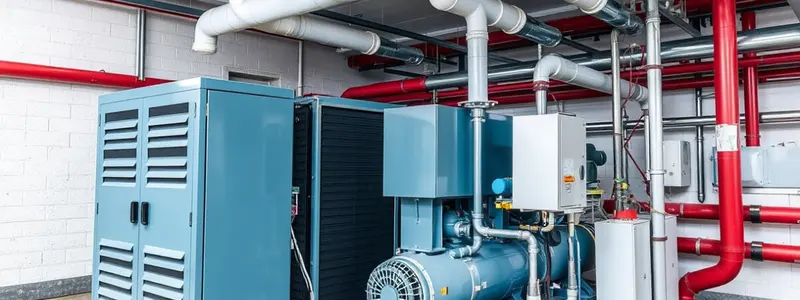Podcast
Questions and Answers
Match the following HVAC components with their descriptions:
Match the following HVAC components with their descriptions:
Boiler = A form of furnace that creates steam. Condenser = The portion of a refrigeration system where the refrigerant releases heat. Evaporator = The component where the refrigerant reduces the temperature of the surrounding area. Cable tray = Elevated platforms used to cover long distances in buildings.
Match the following electrical terms with their definitions:
Match the following electrical terms with their definitions:
Conductor = The metal that distributes electricity throughout the building. Conduit = Durable tubing that protects exposed wiring from damage. Electrical service panel = A panel that brings together circuit conductors and power supply. Emergency power = Power provided by a generator during a power outage.
Match the following elevator operations with their descriptions:
Match the following elevator operations with their descriptions:
Phase I operation = Elevators are recalled to the first floor by smoke detector activation. Phase II operation = Fire fighters control elevators using a special key. Phase III operation = Elevators are used for occupant evacuation before fire fighters arrive. Occupant evacuation elevators = Special elevators for self-evacuation in tall buildings.
Match the following safety systems with their functions:
Match the following safety systems with their functions:
Match the following components with their primary use in buildings:
Match the following components with their primary use in buildings:
Match the following phases of elevator operation with their implications:
Match the following phases of elevator operation with their implications:
Match the following refrigeration components with their roles:
Match the following refrigeration components with their roles:
Match the following terms with their related categories:
Match the following terms with their related categories:
Flashcards are hidden until you start studying
Study Notes
Key Terms in Building Systems
- Boiler: A furnace that generates steam for heating applications in buildings.
- Cable tray: Elevated structures that facilitate the safe routing of electrical and communication cables over long distances in large commercial and industrial facilities.
- Condenser: A refrigeration system component where high-pressure, high-temperature refrigerant releases heat, transitioning from gas to liquid state.
- Conductor: Metal elements, typically copper or aluminum, responsible for the distribution of electricity throughout a building.
- Conduit: Protective tubes or enclosures that safeguard exposed electrical wiring from damage and environmental hazards.
- Diffusion system: A specialized vessel for mixing ammonia with water to reduce ammonia concentration, with the waste disposed of in a sanitary sewer system.
- Electrical service panel: A central panel that consolidates circuit conductors and power supply, managing the distribution and control of electricity within the building.
- Emergency power: Backup power supplied by generators to sustain critical systems like fire pumps and alarms during outages.
- Evaporator: The refrigeration system element where the refrigerant absorbs heat, lowering the temperature of the surrounding air.
- HVAC systems: Integrated systems handling heating, ventilation, and air conditioning to maintain indoor climate comfort.
- Occupant evacuation elevators: Specialized elevators designed for self-evacuation of individuals in skyscrapers over 420 ft (128 m) tall, supporting Phase III operations during emergencies.
Elevator Operation Phases
- Phase I operation: Automatic recall of elevators to the lobby when a smoke detector is activated, allowing occupants to evacuate while keeping doors open for fire fighters.
- Phase II operation: Fire fighters can access designated elevators using a key, allowing them to control the elevators for reaching higher floors safely.
- Phase III operation: Elevators designated for occupant evacuation in emergencies before fire fighters arrive, facilitating safe evacuation procedures.
Refrigeration and Power Terms
- Refrigerant: A fluid that circulates within refrigeration systems, absorbing heat in the evaporator and releasing it in the condenser.
- Standby power: Generated power that supports non-critical building operations during outages, ensuring essential functions can continue without interruption.
Studying That Suits You
Use AI to generate personalized quizzes and flashcards to suit your learning preferences.




